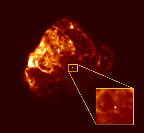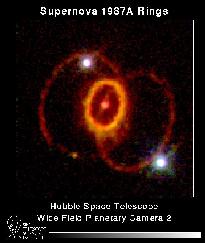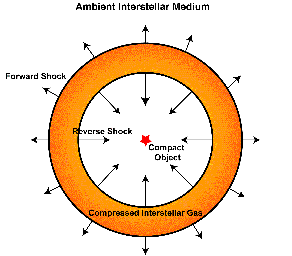
|
Introduction to Supernova Remnants |
What's on This Page
What is a Supernova Explosion (SNe)?
super - 1: very large or powerful (a superatomic bomb)
2: exhibiting the characteristics of its type to an
extreme or excessive degree (supersecrecy)
nova - Etymology: New Latin, feminine of Latin novus,
new.
Plural: novae
1: a star that suddenly increases its light output
tremendously and then fades away to its former
obscurity in a few or years
- Merrian-Webster Dictionary
Supernovae were named because they were objects that appeared to be 'new'
stars, that hadn't been observed before in the well-known heavens. Of
course, the name is actually a bit ironic, since supernovae are actually
stars at the end of their lifecycle, stars that are going out with a bang,
so to speak.
A SNe is the instantaneous release of ~1051 ergs
(1031 Megatons) of energy, the result of either the
catastrophic collapse of a massive star or runnaway nuclear burning on the
surface of a white dwarf. Although only a small fraction of the energy is
released in the form of visible light, this is enough to make it appear as
if a new star has appeared in the sky. The effects of the SNe are
profound and far-reaching, and it is possible to see the remains of SNe
that occured many hundreds of years ago.
Do you want a
more basic description of supernova remnants?
Classification of SNe
 The classification of SNe is an observational one. SNe are broken down into two groups
based on the presence or absence of Hydrogen Balmer lines in their spectra at maximum
brightness. Those without Balmer lines are classified as Type I SNe and those with
Balmer lines are classified as Type II. Supernovae of Type I are further divided into
Type Ia, Ib and Ic. Although the classification is a purely observational one, there
are underlying similarities between the progenitor stars (Type Ia are understood to be
low mass while Type Ib, Ic and II are high mass) that are responsible for the observed
classes of SNe.
The classification of SNe is an observational one. SNe are broken down into two groups
based on the presence or absence of Hydrogen Balmer lines in their spectra at maximum
brightness. Those without Balmer lines are classified as Type I SNe and those with
Balmer lines are classified as Type II. Supernovae of Type I are further divided into
Type Ia, Ib and Ic. Although the classification is a purely observational one, there
are underlying similarities between the progenitor stars (Type Ia are understood to be
low mass while Type Ib, Ic and II are high mass) that are responsible for the observed
classes of SNe.
The Life and Death of a Star
A star is engaged in a continual struggle against collapse due to the gravitational
force of its own mass. In the early stages of its life (the main sequence stage), a
star resists gravity with thermal pressure, as the fusion of elements in its core
releases energy which heats up the star's gas. The hot gas expands, exerting an
outward pressure that balances the inward force of gravity. How this battle of gravity
vs. outward pressure eventually concludes depends upon the initial mass of the star.
Massive Star
At some point in a massive star's life, the center of the star has been
converted to iron and nuclear fusion in the core is no longer an
exothermal process. Nuclear fusion ceases and, without this source of
thermal pressure, gravity, exerting its inexorable pull on the star, seems
to be winning the battle. The star continues its collapse. Then a
strange reaction takes place during which electrons and protons are pushed
so close together that they merge to become neutrons, releasing energy in
the form of neutrinos. There is no available space between the neutrons:
they are supported by neutron degenerate pressure. This halts the
gravitational collapse and the outer, more tenuous stellar material
'bounces' upon hitting the degenerate core, much like a wave hitting a sea
wall bounces back on itself. The conversion of the central core to
neutrons releases 1051 ergs of neutron binding potential
energy, and after the bounce, the outer layers of the star are violently
ejected into the ISM.
If the star starts with between 5 and 12 times the mass of our sun, the
neutron degeneracy pressure in the core is thought to be able to withstand
the gravitational pressure of the star remaining after the supernova
explosion. In this case, a neutron star is left in the center of the SNR.
If the neutron star is rotating, it may become a pulsar, emitting
radiation in a beam which sweeps the earth as the pulsar rotates. If the
star is massive enough, even neutron degenerate pressure will not be able
to hold up against gravitational collapse, and the remains continue to be
squeezed inward by gravity, forrming a singularity, or black hole.
Low Mass Stars
In the usual scheme of things, we expect low mass stars to settle down,
slowly fizzle out and become white dwarfs. Their masses are too low to
bring about the collapse to a neutron star and the resulting spectacle of
a supernova explosion. They resist gravity's pull with electron
degenerate pressure, where the electrons are squeezed until there is no
more space between them. The gravitational pressure of the star is not
enough to cause the conversion to neutrons and the star has reached a
stable equilibrium. However, if the white dwarf is in a binary system
with a red giant, it is possible for the dwarf to accrete matter from its
companion. If enough matter falls on it that it exceeds the Chandresekar
limit for white dwarfs, the star is no longer stable, gravity will
overcome the resistance of electron degeneracy pressure and the star will
collapse. The collapse raises the temperature until carbon and oxygen in
the core start to fuse, igniting a deflagration wave of runnaway nuclear
burning which propagates through the core in seconds. The nuclear fusion
reactions create about a solar mass of radioactive 56Ni. The
energy released is on the order of 1052 ergs, and the white
dwarf is completely disrupted in the process. The star can outshine
entire galaxies while the nuclear fusion proceeds. This is believed to be
the mechanism for Type Ia SNe.
What is a Supernova Remnant (SNR)?
| Most (99%) of the energy of a SNe is released in the form
of energetic neutrinos; the remaining energy is converted into kinetic
energy, accelerating the stellar material to speeds greater than the speed
of sound and causing a shock wave to move outwards from the central star.
The high velocity stellar material plows outwards into the ISM,
compressing and heating ambient gas and sweeping it up much as a snow plow
compacts and sweeps up snow. The ISM becomes enriched with the stellar
material blown off in the explosion. The expanding material, and any
additional material the blast collects as it travels through the
interstellar medium, forms a supernova remnant (SNR). |

|
Although in a simple model of SNRs the explosion energy is deposited
evenly in all directions and the ambient material is swept up in a
uniform, spherical shell, in reality, remnants are much more complicated.
Small differences in the initial conditions of the progenitors, including
previous mass ejections, can have important effects on ejecta propagation.
External conditions, such as density enhancements, in the ISM in which the
SN explodes can shape and mold the morphology of the remnant. And
Rayleigh-Taylor instabilities can cause the surface of the forward shock
to become rippled, mixing the ambient and stellar gases. It is not
surprising that there are various types of SNR: simple Shell type remnants with nothing in their
centers, Crab-like remnants or
plerions with pulsars in their centers
and Composite remnants , a combination of
the first two.
How does the SNR Evolve?
As the ejecta expand out from the star, it passes through the surrounding
interstellar medium, heating it from 107 to 108 K,
sufficient to separate electrons from their atoms and to generate thermal
X-rays. The interstellar material is accelerated by the shock wave and
will be propelled away from the supernova site at somewhat less than the
shock wave's initial velocity. This makes for a thin expanding shell
around the supernova site encasing a relatively low density interior.
|
|
While the material swept up by the shock is much less than the mass of the
stellar ejecta, the expansion of the stellar ejecta proceeds at
essentially a constant velocity equal to the initial shock wave speed,
typically of the order of 10,000 km/s. This is known as the "free
expansion" phase and may last for approximately 200 years, at which
point the shock wave has swept up as much interstellar material as the
initial stellar ejecta. The supernova remnant at this time will be about
10 light years in radius. Although the remnant is radiating thermal X-ray
and synchrotron radiation across a broad range of the electromagnetic
spectrum (from radio to X-rays), the initial energy of the shock wave will
have diminished very little. Line emission from the radioactive isotopes
generated in the supernovae contribute significantly to the total apparent
brightness of the remnant in the early years, but do not significantly
effect the shock wave. | As the remnant sweeps up
ambient mass equal to the mass of the stellar ejecta, the wave will begin
to slow and the remnant enters a phase known as adiabatic expansion, or
the Sedov-Taylor or blast wave phase. The internal energy of the shock
continues to be very large compared to radiation losses from thermal and
synchrotron radiation, so the total energy remains nearly constant. The
rate of expansion is determined solely the initial energy of the shock
wave and the density of the interstellar medium.
As the shock wave cools, it will become more efficient at radiating
energy. Once the temperature drops below 20000 K or so, some electrons
will be able to recombine with carbon and oxygen ions, enabling
ultraviolet line emission which is a much more efficient radiation
mechanism than the thermal X-rays and synchrotron radiation. Hence this
new phase is known as the radiative phase during which X-ray radiation
becomes much less apparent and the remnant cools and disperses into the
surrounding medium over the course of the next 10000 years.
Supernova remnants are extremely important for our understanding of our
Galaxy. They are the source of much of the energy that heats up the
interstellar medium. They are believed to be responsible for the
acceleration of galactic cosmic rays. Heavy elements (up to iron) created
by fusion in the stellar core are dumped into the galaxy by the mixing of
the ejecta and ISM material in the remnant. Enriched, heated gas from SNR
material is reprocessed to form new stars. Elements heavier than iron are
created in the powerful blast of a SN explosion and are then dredged up by
the shock wave and mixed into the ISM. Most of the elements (except for
Hydrogen) in your body, for example, are stellar material that has been
redistributed in a SNR. Understanding how SNR evolve can thus help us to
understand many important phenomena.
Modeling SNR
One technique for understanding SNR is to develop a "model" SNR, which is
simplified but contains important characteristics common to all SNR, such
as the initial energy of the explosion. Such models, which can be either
analytical (as an equation, for example, of the size of the remnant as a
function of time) or numerical (simulations) can predict X-rays or other
emission we would expect to see. These predictions can then be compared
with observed SNR to see how well the model fits.
Analytical models are few, since the equations governing the motion of the
SNR gas are very complex and cannot be solved for except in very limited
special cases (spherical geometry and constant energy, for example). In a
numerical model, the evolution of the ejecta and ISM gas, fit onto a
computational grid, is followed over time, by using the conservation
equations of mass, momentum and energy . Numerical models are constrained
by limits on the time and space it takes to run the simulation and then
store the data. It is not difficult, for example, to perform simulations
that have spherical or cylindrical symmetry (1-dimensional and
2-dimensional, respectively), but many of the more complicated structures
found in real SNR are destroyed by the imposition of this kind of
symmetry. Fully 3-dimensional simulations, on the other hand, are
computationally very expensive, particularly if they are of sufficient
resolution (small enough numerical grid size) so that small features such
as small scale turbulence, do not get averaged out.
Despite the difficulties, many good SNR models have been developed, which
increase our understanding of how they evolve and how they interact with
the surrounding ISM, including the following:
-
Lyerley et al. (abstract for a Bulletin of the American
Astronomical Society article entitled Nonequilibrium-Ionization
X-ray
Spectra from a Sedov-Taylor Blast Wave Model for a Supernova Remnant
)
-
Truelove & McKee (abstract for a Bulletin of the American
Astronomical Society article entitled Evolution of Nonradiative
Supernova
Remnants )
-
Reynolds, S. P. (abstract for a Bulletin of the American
Astronomical
Society article entitled Theoretical Calculations of Synchrotron
X-rays
from Supernova Remnants: Images and Spectra)
How Does X-ray Astronomy Fit in?

The Puppis A remnant with the ROSAT neutron star discovery

Optical image of the Crab Nebula |
There are several mechanisms by which SNR generate
X-rays. The ejecta, heated and comressed by the powerful forward shock,
generates thermal and line emission in the X-ray region of the spectrum.
Electrons, accelerated by the SNR shock to relativistic speeds emit
synchrotron radiation when they change direction in the presence of a
magnetic field. And a neutron star formed in a Type II SNe may also be
a
significant source of X-rays.
The X-rays emitted by SNR give us many clues that help us understand SNR,
their progenitor stars, and their interaction with the ISM. We usually
know little about the progenitor star, however, X-ray spectra of the shock
heated ejecta in the remnant offer direct information about the
composition of the progenitor star. X-ray spectra can also give
information on the composition of the ISM into which the remnant is
expanding, if and to what extent the elemental layers of the progenitor
star are mixed with the gas of the ISM. By studying the X-ray morphologies
of SNR, we can learn about how thermal conduction acts in SNR and in the
ISM. Looking for X-ray synchrotron radiation is a way of getting direct
evidence for cosmic ray acceleration in SNR shocks.
|
The hot material, the radioactive isotopes, free electrons moving in the
strong magnetic field of the neutron star... all of these processes
produce X-rays and gamma rays which reveal the nature of the SNR.
Further SNR Resources and References
|
|
Additions or Comments:
Have we left anything out? Is there something you would like to have added
to this page (a link to your own group's research page, for example...)?
|
IMAGES |
By Mission |
Stars |
Cataclysmic Variables |
X-ray Binaries |
Pulsars |
Supernova Remnants & Planetary Nebulae |
Galaxies |
Active Galactic Nuclei |
Clusters and Groups of Galaxies |
X-ray/gamma-ray Background & Deep Fields |
Solar System Objects |
Gamma Ray Bursts
HEASARC Home |
Observatories |
Archive |
Calibration |
Software |
Tools |
Students/Teachers/Public
Last modified: Wednesday, 11-May-2011 14:17:37 EDT
|